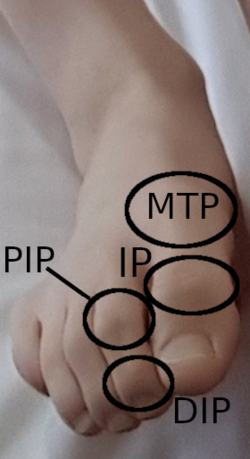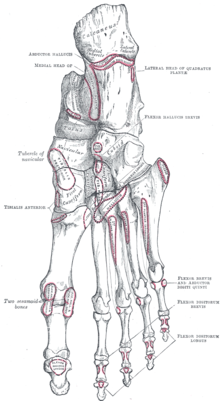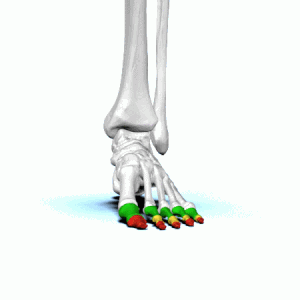Interphalangeal joints of the foot
| Interphalangeal joints of foot | |
|---|---|
 The MTP, IP, PIP, and DIP joints of the foot:
| |
 Bones of the foot. Interphalangeal joints highlighted (orange background area) | |
| Details | |
| Identifiers | |
| Latin | articulationes interphalangeae pedis |
| MeSH | D014033 |
| TA98 | A03.6.10.901 |
| TA2 | 1968 |
| FMA | 35225 71357, 35225 |
| Anatomical terminology | |
The interphalangeal joints of the foot are the joints between the phalanx bones of the toes in the feet.
Since the great toe only has two phalanx bones (proximal and distal phalanges), it only has one interphalangeal joint, which is often abbreviated as the "IP joint". The rest of the toes each have three phalanx bones (proximal, middle, and distal phalanges), so they have two interphalangeal joints: the proximal interphalangeal joint between the proximal and middle phalanges (abbreviated "PIP joint") and the distal interphalangeal joint between the middle and distal phalanges (abbreviated "DIP joint").
All interphalangeal joints are ginglymoid (hinge) joints, and each has a plantar (underside) and two collateral ligaments. In the arrangement of these ligaments, extensor tendons supply the places of dorsal ligaments, which is similar to that in the metatarsophalangeal articulations.
Toe bones or phalanges of the foot. Note the big toe has no middle phalanx.
People vary; sometimes the smallest toe also has none (not shown).[1]
Movements
[edit]The only movements permitted in the joints of the digits are flexion and extension; these movements are more extensive between the first and second phalanges than between the second and third. The flexor hallucis longus and flexor digitorum longus flex the interphalangeal joint of the big toe and lateral four toes, respectively. The tendons of both of these muscles cross as they reach their distal attachments. In other words, the flexor hallucis longus arises laterally, while the flexor digitorum longus arises medially.
The amount of flexion is very considerable, but extension is limited by the plantar and collateral ligaments.

See also
[edit]References
[edit]- ^ Hatch, RL; Hacking, S (15 December 2003). "Evaluation and management of toe fractures". American Family Physician. 68 (12): 2413–8. PMID 14705761.
![]() This article incorporates text in the public domain from page 359 of the 20th edition of Gray's Anatomy (1918)
This article incorporates text in the public domain from page 359 of the 20th edition of Gray's Anatomy (1918)
| Hip | |||||
|---|---|---|---|---|---|
| Knee |
| ||||
| Tibiofibular |
| ||||
| Foot | |||||
Text is available under the CC BY-SA 4.0 license; additional terms may apply.
Images, videos and audio are available under their respective licenses.


